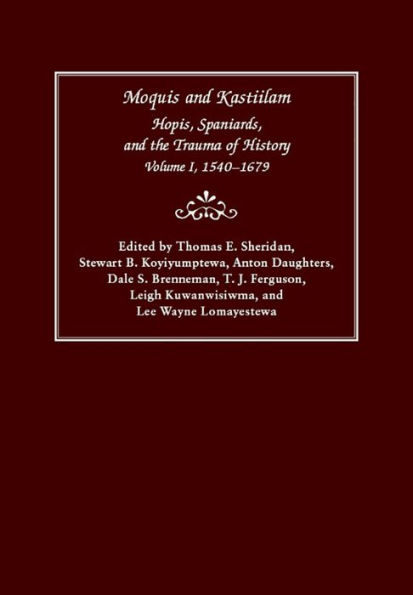5
1

Moquis and Kastiilam: Hopis, Spaniards, and the Trauma of History, Volume I, 1540-1679
360
Moquis and Kastiilam: Hopis, Spaniards, and the Trauma of History, Volume I, 1540-1679
360Hardcover(3rd ed.)
$75.00
-
PICK UP IN STORECheck Availability at Nearby Stores
Available within 2 business hours
Related collections and offers
75.0
In Stock
Overview
The first of a two-volume series, Moquis and Kastiilam tells the story of the encounter between the Hopis, who the Spaniards called Moquis, and the Spaniards, who the Hopis called Kastiilam, from the first encounter in 1540 until the eve of the Pueblo Revolt of 1680. By comparing and contrasting Spanish documents with Hopi oral traditions, the editors portray a balanced presentation of their shared past. Translations of sixteenth-, seventeenth-, and eighteenth-century documents written by Spanish explorers, colonial officials, and Franciscan missionaries tell the perspectives of the European visitors, and oral traditions recounted by Hopi elders reveal the Indigenous experience. The editors argue that the Spanish record is incomplete, and only the Hopi perspective can balance the story. The Spanish documentary record (and by extension the documentary record of any European or Euro-American colonial power) is biased and distorted, according to the editors, who assert there are enormous silences about Hopi responses to Spanish missionization and colonization. The only hope of correcting those weaknesses is to record and analyze Hopi oral traditions, which have been passed down from generation to generation, and give voice to Hopi values and Hopi social memories of what was a traumatic period in their past. Spanish abuses during missionization—which the editors address specifically and directly as the sexual exploitation of Hopi women, suppression of Hopi ceremonies, and forced labor of Hopis—drove Hopis to the breaking point, inspiring a Hopi revitalization that led them to participate in the Pueblo Revolt. Those abuses, the revolt, and the resistance that followed remain as open wounds in Hopi society today.

Product Details
| ISBN-13: | 9780816531844 |
|---|---|
| Publisher: | University of Arizona Press |
| Publication date: | 11/12/2015 |
| Edition description: | 3rd ed. |
| Pages: | 360 |
| Product dimensions: | 7.00(w) x 10.10(h) x 1.00(d) |
About the Author
Thomas E. Sheridan holds a joint appointment as research anthropologist at the University of Arizona’s Southwest Center and professor in the School of Anthropology. He received his PhD in anthropology from the University of Arizona in 1983. Stewart B. Koyiyumptewa received his BA from the University of Arizona in 1999. He is currently the archivist for the Hopi Tribe’s Cultural Preservation Office. Anton Daughters is an assistant professor of anthropology at Truman State University. He received his PhD from the University of Arizona in 2010 and was an Andrew W. Mellon Postdoctoral Fellow at Cornell College from 2010 to 2012. Dale S. Brenneman is associate curator of documentary history and director of the Office of Ethnohistorical Research at the Arizona State Museum. She received her PhD in anthropology from the University of Arizona in 2004. T. J. Ferguson received his PhD in anthropology from the University of New Mexico in 1993. Since 2002, he has served as a professor of anthropology at the University of Arizona, in addition to being the sole proprietor at Anthropological Research, LLC. Leigh Kuwanwisiwma is the director of the Cultural Preservation Office of the Hopi Tribe. He is a member of the Hopi Tribe and of the Greasewood Clan. He has served on the Arizona Archaeology Commission, the Museum of Northern Arizona Board of Trustees, the Tribal Advisory Team of the Arizona State Museum, and the Museum of Indian Arts and Culture. LeeWayne Lomayestewa, a member of the Hopi tribe and the Bear Clan, is a research assistant and the NAGPRA coordinator for the Hopi Cultural Preservation Office of the Hopi Tribe. He serves as the president of the Native Nations Southwest Advisory Panel at the Arizona State Museum and as a member of the Indian Advisory Panel at the Museum of Indian Arts and Culture in Santa Fe, New Mexico.
Table of Contents
List of Illustrations Acknowledgments Introduction: Oral Traditions, Collaborative Research, and Hopi History III. The Pueblo Revolt IV. The Reconquista of Nuevo México and the Destruction of Awat’ovi V. Tewa-Tano Settlers on First Mesa VI. Rebuffing the Spaniards VII. Jesuits versus Franciscans and the Hopi Missions VIII. The Resettlement of Pueblo Refugees in the 1740s IX. Trails to California Appendix 1. Hopi and Tewa Consultants Appendix 2. University of Arizona Staff and Graduate Student Researchers Notes Glossary References IndexFrom the B&N Reads Blog
Page 1 of
